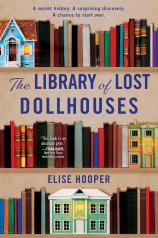The Library of Lost Dollhouses
Review
The Library of Lost Dollhouses
From Elise Hooper, the author of such novels as THE OTHER ALCOTT and ANGELS OF THE PACIFIC, comes THE LIBRARY OF LOST DOLLHOUSES, a captivating tale of miniatures and mysteries that highlights the tenacity and inventiveness of overlooked women throughout time.
When we meet Tildy Barrows in February 2024, the Belva Curtis LeFarge Library --- to which Tildy has dedicated herself and her career as head curator --- is in a deep financial hole. The 2008 recession nearly tanked the esteemed library, but the pandemic sealed its fate. Rather than attracting investors, its unique position as a research institution, a historical site, an art museum and a community center seems to turn away sponsors who prefer a more dedicated focus.
Founded by Belva Curtis LeFarge herself, heiress to a transcontinental fortune, the library boasts numerous books, paintings, periodicals, clothes, music, maps and other ephemera. Tildy knows them all intimately. She is the one who gives tours to guests, calls repairmen when something is broken, and finds new and interesting ways to attract investors. So it is to her great surprise that she uncovers a hidden room behind a pocket door. In it are two grand dollhouses.
"...a captivating tale of miniatures and mysteries that highlights the tenacity and inventiveness of overlooked women throughout time.... Riveting, heartwarming and illuminatingly educational, THE LIBRARY OF LOST DOLLHOUSES is exactly what the historical fiction genre was invented for."
If you live in this era, no doubt you know a little girl with a dollhouse, or perhaps you even own one yourself. But as Hooper describes it, dollhouses were not actually considered toys until mass manufacturing after World War II made them widely available. Before then, particularly in Belva’s time, they were commissioned by upper-class ladies as status symbols of wealth. The cost of production, paired with the extreme levels of craftsmanship that go into them, made them not toys, but supreme works of art.
As a historian and curator, Tildy knows all of this, right down to the history of Queen Mary’s dollhouse, a five-story structure with an elevator and running water, which drew more than a million viewers when it was put on display in 1924. So to point out that even she is shocked by the care and attention to detail demonstrated in the two hidden dollhouses is really saying something.
Tildy is quick to identify the inspiration for the first dollhouse --- a magnificent structure of 13 rooms, each decked out in tiny paintings, bejeweled chandeliers and elegant wainscoting --- as a miniature version of Hôtel LeFarge, the Paris mansion where Belva lived after her marriage to aristocrat Comte LeFarge in the early 1900s. The second dollhouse is colossal --- four stories high and 30 rooms --- and designed like a grand country estate, complete with a gallery. The precision of artistry on both is staggering, leaving Tildy with one question: Why were these master-level works of art hidden?
Then a closer look reveals something even more haunting. On the top floor of the LeFarge miniature, where Belva’s bedroom is located, there is a portrait not of Belva, but of Tildy’s late mother at the age of 12. In the 34 years Tildy shared with Meg Leigh Barrows, the woman never once discussed her own childhood, save for half-stories about deceased parents and a boarding school in New Hampshire. So how is it possible that a picture of her at 12 has ended up in the Bel...in a hidden dollhouse in a hidden room, no less?
Inspiration strikes, and Tildy realizes that she has a chance to both save the Bel and learn more about her mother. Rather than investigating the dollhouses herself, she and her colleagues will open up the Bel to the public and invite them to solve the mystery. A signature of “C.H.” is their first clue, and with the local news running a story on the magnificent dollhouses, Tildy waits for the public to fill in the blanks.
In an alternate storyline, readers meet the C.H.: Cora Hale, a 17-year-old orphaned artist who has arrived in Paris for a fresh start after a scandal sent her running from the States. She has been referred to Curtis House, an esteemed boardinghouse that houses female artists of all types, run by benefactor Comtesse LeFarge, aka Belva. Belva sees something special in Cora, who is soon taken under her wing, and eventually she commissions a grand dollhouse (the Hôtel LeFarge) from the young woman, even as war breaks out throughout the continent.
Appropriately titled “The Confessions of Cora Hale,” these chapters introduce a spellbinding new mystery and scandal, one that sends the reader racing to the present as Tildy attempts to find, reveal and credit the magnificent artist who just may be the answer to saving the Bel…and learning the truth about her mother.
Riveting, heartwarming and illuminatingly educational, THE LIBRARY OF LOST DOLLHOUSES is exactly what the historical fiction genre was invented for. Hooper warmly invites us in by using the vehicle of dollhouses --- a toy, in modern readers’ minds --- then completely upends all we thought we knew about history, artistry and, well, dollhouses. Beyond being staggering works of craftsmanship, these miniature mansions provide us with a seemingly contradictory sense of both control and imagination, allowing us to recreate the world as we see (or want to see) it.
As witnessed through Hooper’s deft, lyrical prose and meticulous research, this tiny world of miniatures expands and explodes, revealing decades of women’s hard work, resourcefulness and well-kept secrets. The dollhouses were portraits not just of other buildings or even their artists, but of the female commissioners themselves. Forced to survive and thrive in a world carved out for men, they were keenly capable of hiding their secrets from the opposite sex while crafting ingenious ways of messaging and revealing themselves to fellow women.
Reviewed by Rebecca Munro on May 2, 2025
The Library of Lost Dollhouses
- Publication Date: April 1, 2025
- Genres: Fiction, Historical Fiction, Women's Fiction
- Paperback: 320 pages
- Publisher: William Morrow Paperbacks
- ISBN-10: 0063382148
- ISBN-13: 9780063382145




